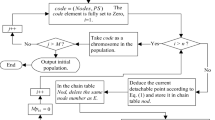Abstract
This paper focuses on the cooperative disassembly sequence planning (CDSP) problem which is essential to disassembly a large and complex product in practice. A disassembly hybrid graph model (DHGM) is constructed to describe the mating contact and noncontact priority relationships among constituting product components. Thus, the disassemblability constraint expression can be deduced from it by reasoning. The CDSP is different from the disassembly sequence planning except for they are NP-complete. Therefore, a novel method is presented to generate cooperative disassembly hierarchical tree (CDHT) from the DHGM based on branch-and-bound algorithm in which two user-defined variables are introduced to control the size of the CDHT .The optimal solutions with a minimal disassembly time are derived according to the objection function. Finally, an example illustrates the proposed method.
Similar content being viewed by others
References
Dutta D, Woo TC (1995) Algorithm for multiple disassembly and parallel assemblies. ASME J Eng Ind 117:102–109
Zhang HC, Kuo TC (1997) A graph-based disassembly sequence planning for EOL product recycling. Twenty-first IEEE/CPMT International Electronics Manufacturing Technology Symposium. Piscataway, New Jersey, pp 140–151
Homem de Mello LS, Sanderson AC (1990) AND/OR graph representation of assembly plans. IEEE Trans Rob Autom 6:188–199
Moore KE, Gungor A, Gupta SM (2001) Petri net approach to disassembly process planning for products with complex AND/OR precedence relationships. Eur J Oper Res 135(2):428–449
Kaebernick H, O’Shea B, Grewal SS (2000) A method for sequencing the disassembly of products. CIRP Ann 49:13–16
Li JR, Khoo LP, Tor SB (2002) A novel representation scheme for disassembly sequence planning. Int J Adv Manuf Technol 20:621–630
Lambert AJD, Gupta SM (2008) Methods for optimum and near optimum disassembly sequencing. Int J Prod Res 46(11):2845–2865
González B, Adenso-Díaz B (2006) A scatter search approach to the optimum disassembly sequence problem. Comput Oper Res 33:1776–1793
Kongar E, Gupta SM (2006) Disassembly sequencing using genetic algorithm. Int J Adv Manuf Technol 30:497–506
McGovern SM, Gupta SM (2006) Ant colony optimization for disassembly sequencing with multiple objectives. Int J Adv Manuf Technol 30:481–496
Wang JF, Liu JH, Li SQ, Zhong YF (2003) intelligent selective disassembly using the ant colony algorithm. Artif Intell Eng Des Anal Manuf 17:325–333
Tripathi M, Agrawal S, Pandey MK, Shankar R (2008) Real world disassembly modeling and sequencing problem: optimization by algorithm of self-guided ants (ASGA). Robot Comput-Integr Manuf 25:2–12
Li XY, Shao XY, Gao L (2008) Optimization of flexible process planning by genetic programming. Int J Adv Manuf Technol 38:143–153
Woo TC, Dutta D (1991) Automatic disassembly and total ordering in three dimensions. ASME J Eng Ind 113:207–213
Chen SF, Oliver JH, Chou SY, Chen LL (1997) Parallel disassembly by onion peeling. ASEM J Mech Des 119:267–274
Kang JG, Lee DH, Xirouchakis P, Persson JG (2001) Parallel disassembly sequencing with sequence-dependent operation times. CIRP Ann-Manuf Technol 50(1):343–346
Torres F, Puente ST, Aracil R (2003) Disassembly planning based on precedence relations among assemblies. Int J Adv Manuf Technol 5(21):317–327
Díaz C, Puente S, Torres F (2006) Task planner for a cooperative disassembly robotic system. Inf Control Prob Manuf 2006:161–166
Gungor A, Gupta SM (2001) Disassembly sequence plan generation using a branch-and-bound algorithm. Int J Prod Res 39(3):481–509
Kim HJ, Kernbaum S, Seliger G (2009) Emulation-based control of a disassembly system for LCD monitors. Int J Adv Manuf Technol 40:383–392
Author information
Authors and Affiliations
Corresponding author
Rights and permissions
About this article
Cite this article
Zhang, X.F., Zhang, S.Y. Product cooperative disassembly sequence planning based on branch-and-bound algorithm. Int J Adv Manuf Technol 51, 1139–1147 (2010). https://doi.org/10.1007/s00170-010-2682-7
Received:
Accepted:
Published:
Issue Date:
DOI: https://doi.org/10.1007/s00170-010-2682-7




